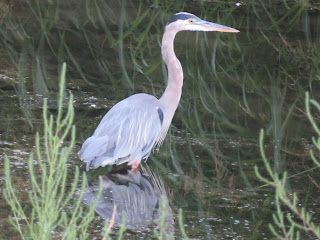Fall is coming. We have ducks and Canada geese have appeared, there are more hummingbirds around. There are more of all types of birds.
This Swainson's hawk appears to be moving into the Bosque. They are far less seen than the Coopers and Red tailed hawks for most of the year.
Possibly the same hawk cruising over the bosque in slow circles, getting the lay of the land. Old mature trees are important roost sites for these big birds.
At a pinch. a telephone pole will work, as well. These bigger birds seem to have the place to themselves for now, but there are some other raptors I haven't been able to identify or photograph yet out there.Says phoebe and other flycatchers appear to be the only birds that can winnow bagworms out of the bags by banging them on branches. They also tolerate hummingbird harassment better than other birds. I have watched them coolly stare down a frantic hummer.
We are seeing more hummingbirds than last month. I suspect the sugar will be important for the arduous migration back down into central America that should be starting soon.
There are starting to be a lot more bird species around as the fall begins to be feltWebworms have a communal net they hide under. they are also spiny. I see a few nests each year. I hear they can be very prevalent at certain places.
This poor picture was quickly snapped because I noticed the weird, darting behavior. It turns out it is a spider hunting wasp that was looking for a spider to paralyze and feed on.I think this is a satellite fly, there are many buzzing insects around, but there is a lot more variety than people would expect.
The insects are very vocal right now but are likely to start getting smaller as we enter fall. This katydid has a back leg that is bent weird. It likely still has a soft molted shell that hasn't hardened yet.
Almost all the birds should be done with nesting by this time of year. Of course that doesn't mean that the birds read the rule books This nest is reused each year.
This bullfrog looks a little skinny. He has probably been defending his patch of the water for quite a while now. The clear water of scuzzy has been replaced by the milky brown water backing up from the irrigation ditch.
There are many skinks around. This great plains skink is an adult and has a damaged, forked tail that is not seen well in this picture. You can see where the tail has grown back about halfway down. The juveniles are black with bright blue tails.
As the nights begin to cool, the more delicate plants begin to sprout. This is the time for many trees to grow in the shade, like elms. Any bare ground with some moisture and shade is likely to have some pale green popping out.
Rainbows are unique visions that require the full sun to be close to the horizon and fine droplets of rain in the air. Someone has coined the term "spotsoon" for the patchy type of rainfall we hare having now.
Rain, of course, means water washing into the ditches. This water contains all sorts of things like fertilizer and animal waste. This creates blooms of duckweed that shade water plants and hide insects
The edges of paths are usually thickly coated by pigweeds (in the amaranth family) and other plants that get pretty tall and thick. Out in the open, the strong light washes out the colors but helps with the contrasts by having deep shadows.
The grasses growing under the mature cottonwoods really look pretty this time of year as the days begin to get shorter. The delicate pinks of the flowering grass stalks need a neutral sunlight to bring out their color.





















No comments:
Post a Comment